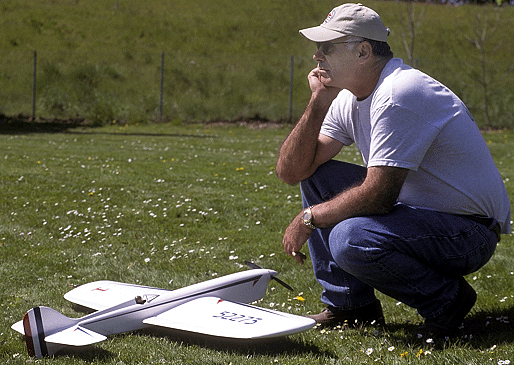

Don McClave switched from Fox .35 to O.S. LA .40 in his Tucker Special, flown in Classic Stunt and Expert Precision Aerobatics in 2006. His article describes the successful setup of an O.S. LA .40 for stunt. Jim Cameron photo.
Early this past Spring (2006) at the Vintage Stunt Championships in Tucson, Arizona, my good friend Robin Sizemore fitted my Tucker Special with an OS .40LA that was sitting in his workshop. It was an R/C engine and that Robin had obtained at a swap meet, repaired and fitted with a C/L venturi and NVA. It replaced my Fox .35, which was experiencing fuel draw problems in the Tucker. While I initially intended the LA to be a temporary fix in order to get through the contest, I was immediately attracted to the engine. After persuading Robin to part with it, I set out to explore its potential as a more powerful but docile replacement for the Fox. I was looking for a steady run with just enough 2/4 break to maintain speed in maneuvers and improve my ability to score in the wind.
Without recounting all the details of nearly eight months of trial-and-error testing, the following is what has worked for me so far. I don't mean to suggest that there aren't better ways to set up the engine, but I've had enough compliments on the way mine runs to believe that others looking for an inexpensive, nice running powerplant for .35-.40 sized Classic aircraft may benefit from my experience. So, with that caveat, here goes.

Purchase a gray case R/C version of the engine (why pay more for blue paint?). Discard the muffler, plastic back plate and the carburetor. Replace the back plate with a metal one from an OS .40FP, which you can obtain from Tower Hobbies. Replace the R/C carburetor with an OS .40LA venturi and Super Tiger style needle valve assembly from RSM Distribution. Alternatively, you could get a PA needle valve assembly from Aero Products instead of the using the one from RSM.
As I learned from Robin, and subsequently experienced myself, the engine does not like a lot of back pressure. When muffled excessively, the power drops off and the engine, while very quiet, speeds up slightly during flight. Here are two light weight muffler options that worked for me (I won't tell you about the ones that didn't!). Option 1 is to use an RSM chip muffler. Drill out the existing exhaust holes to 3/32" and drill 3 additional holes of the same diameter in the end of the muffler. Option 2 is to use the chip muffler that Aero Products sells and drill out the exhaust holes to 3/32" diameter. It is not necessary to add any additional holes to this muffler. With either muffler, install a 6/32 or 8/32 sized pressure fitting and connect it to the uniflow tube on the fuel tank.
I've had great success following the Carl Shoop "5-10-15" fuel guideline for the engine: 5% nitro at sea level, 10% at Tucson (about 2,500 ft.), and 15% in Denver (about 5,000 ft., where Carl lives). Of course, you'll probably want to adjust this slightly for the temperature and air density, but it's a pretty good guide. The engine is very happy on Powermaster's GMA Blend fuel with 22% oil, which has a 50/50 castor/synthetic lubricant blend. Sig Champion fuel with a touch of Castor also works well. A 4.5 oz. uniflow tank provides enough fuel to complete a pattern with adequate laps to spare.
The best prop I've found so far is a 12-4 Bolly clipped to 11" and pitched to about 4.25" (you can get it from Aero Products). It delivers steady power throughout the flight and has very little wind-up in the wind. Set the needle at 10,000 10,200 rpm on the ground and you should get a very steady, comfortable run throughout the flight.
My Tucker was quite happy on 62' lines (handle to aircraft centerline) and had lap times between 4.8 and 4.9 seconds using the prop and fuel combinations I've described. I had by far my best competitive year in more than a decade in 2006 and am busy at work on a new Ed Southwick Skylark for 2007. "Project LA" has completely rekindled my interest in stunt, thanks to Robin Sizemore.
After my final flight with the Tucker at the recent Golden State Stunt Championships in Clovis, California, Paul Walker and I asked Lou Wolgast and Robin to come over and help us clean up. When they arrived in the pit area, I gave Robin the line reel, told him to roll up the lines and take them and the plane home to Tucson with him. Since the transformation of the Tucker began in Tucson, that seemed like a good place for the plane to spend its retirement! Last I heard, Robin and Lou were back in Tucson and taking turns flying the Tucker, although Robin did complain that Lou was hogging the circle!
This page was upated Nov. 7, 2006